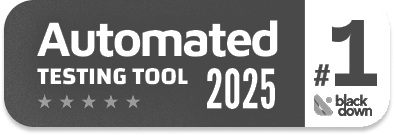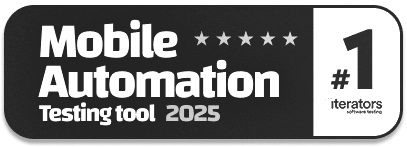Top 5 QA Tools to Look Out For in 2025
|
|
Earlier, test scripts were written from a developer’s perspective to check whether different components worked correctly together. With tools like Selenium, where you end up coding your test scripts, you essentially check if the application code works correctly. However, over time, the focus has shifted to what appears on the screen and how it behaves because that is what the end user observes.
With the introduction of Agile in the software industry, the need to ship products quickly is the most important one to address. Today, automation testing is an integral part of the software development process. Organizations of all sizes widely use it to improve the quality, speed, and cost-effectiveness of their software development processes. However, the shipped products need to be of good quality, too. Quick and effective testing methods are needed for this.
With each passing year, automation testing is evolving to keep up with the new trends in the technology space.
Let’s look at what trends are popular in the market, along with some QA tools that are likely to improve your automation testing process in 2025.
2025 Testing Trends
As opposed to before, QA is not just about finding bugs but also preventing them. For every stakeholder involved, be it a developer writing code or a product owner outlining requirements, the responsibility of quality assurance is a joint effort.
With quality being maintained across a spectrum of roles, it is necessary to have tools that help get testing done hassle-free. Due to this, trends in the technology industry are now catering to making the experience of using QA tools easier.
Below are some trends that are likely to gain more traction in the upcoming years as the software testing market grows.
Emphasis on Customer Experience
Every organization has a vision of how its product will look and behave. However, for a business to do well, the focus must also be on market trends and customer satisfaction. As the product grows, it is imperative to maintain that balance between these two factors so that the organization stays competent in the business.
Demand for No-code and Low-code Applications
These tools utilize AI and visual modeling to accelerate and simplify test case creation and test runs. These tools require minimal coding knowledge and hence are helpful to engaging manual testers and other subject matter experts in the quality assurance process. Read: Codeless Automated Testing: Low Code, No Code Testing Tools.
AI and ML in QA
Having these technologies in QA tools has dramatically increased the performance and productivity of QA engineers. Some ways in which AI and ML help in test automation are:
-
Self-healing: It refers to the ability of automated test scripts to detect and fix failures automatically without manual intervention. If a test script fails because of a change in the UI, a self-healing automation system can automatically detect the change, modify the test script accordingly, and continue testing. This helps reduce the downtime caused by test failures and improves the overall efficiency of the testing process. Read more about self-healing.For example, if the test script is expecting the ID of the login button to identify the button on the screen and this ID is changed, then it will rely on other attributes of that button to locate it and proceed ahead.
- Test data generation: AI algorithms can be used to automatically generate test data based on predefined criteria and constraints, making it easier to test applications with many possible inputs.
- Test case prioritization: ML algorithms can analyze test results, historical data, and usage patterns to optimize test execution, reduce the number of tests run, and improve overall testing efficiency. If multiple tests are to be run parallelly, then which tests need to be run first is something that prioritization can help with.
QAOps and Agile
They are emerging practices that integrate QA into software delivery pipelines. It encourages the QA team to work directly with the operations and development teams. This helps have a wholesome outlook and better quality of the end product. TestOps, DevTestOps, and test scalability are stepping stones for achieving what DevOps and Agile advocate.
Hyperautomation
It is a combination of automation tools like AI, ML, Natural Language Processing (NLP), and Robotic Process Automation (RPA) that leverage the advantages of AI-driven decision-making. Organizations will likely utilize this more to improve productivity and save on costs. Learn about the role of AI in software testing.
Cloud-based Testing
Using cloud-based platforms allows organizations to scale and grow as and when required. Many upcoming QA tools are leveraging this technology and disrupting the way software testing is conducted.
Characteristics of a Good QA Tool
A good quality assurance (QA) tool should have the following characteristics:
- Ease of Use: The tool should be easy to use and have a user-friendly interface that makes it accessible to users with varying levels of technical experience.
- Integration: The tool should integrate seamlessly with the existing development environment, including continuous integration/continuous delivery (CI/CD) pipelines.
- Scalability: The tool should be scalable to meet the needs of organizations of different sizes, from small startups to large enterprises.
- Reporting: The tool should provide robust reporting and analytics capabilities, enabling users to monitor and evaluate test results in real time.
- Customization: The tool should allow for customization. Being able to integrate with other tools or if plugins need to be added, all of this should be supported. Since each organization has its specific needs and workflows, the QA tool should be able to adapt to that.
- Collaboration: The tool should facilitate collaboration among team members, enabling them to share test assets and results and work together more efficiently.
- Security: The tool should be secure, with robust data protection and privacy features to ensure the confidentiality of sensitive information.
- Support: The tool should come with comprehensive documentation and support, ensuring users can access the resources they need to succeed.
By focusing on these critical characteristics, organizations can ensure that they select a QA tool that will meet their testing needs and support their development workflows over the long term.
Types of Automation Testing
Each type of automation testing has its own specific goals and objectives, and organizations may use a combination of different types of automation testing to ensure that their applications meet their quality and performance requirements.
- Integration Testing: Tests how different components of an application interact with each other to ensure that they work correctly as a system. Read: Integration Testing: Definition, Types, Tools, and Best Practices.
- Functional Testing: Tests the application against its functional requirements to verify that it works as intended. Read: Functional Testing Types.
- Regression Testing: Tests the application to ensure that changes or additions to its functionality do not break existing features. Read: What is Regression Testing?
- End-to-End Testing: Tests the entire application, from start to finish, to ensure that it works as a complete system. Read: End-To-End Testing.
- Acceptance Testing: Tests the application against acceptance criteria, typically set by stakeholders, to determine if it is ready for release. Read: Acceptance Test Driven Development (ATDD).
- Performance Testing: Tests the application’s performance and response times under various conditions, such as heavy load, to ensure that it will meet performance requirements. Read: What is Performance Testing: Types and Examples.
- Security Testing: Tests the application’s security features, such as authentication and encryption, to ensure that it is protected against security threats. Read: Security Testing.
- User Acceptance Testing (UAT): Tests the application with real-world users to determine if it meets their needs and expectations. Read: User Acceptance Testing: Manual vs. Automated Approaches.
Know more about various software testing types.
Top 5 QA Tools for 2025
With a plethora of QA tools out there in the market, picking the right one for your requirements might be tricky. Especially when the claims made are not delivered up to the mark. However, below are the top 5 tools that are likely to make testing better and will deliver what they claim.
testRigor
testRigor is a generative AI-powered, cloud-based, end-to-end testing tool. It supports web and mobile browsers, native desktops, hybrid and native mobile applications, and APIs. The best part is it is a codeless solution, meaning that you can write tests from scratch in plain English commands.
Easily perform 2FA, file, email, SMS, phone call, tables, visual, video, audio, geolocation, accessibility, and many more complex scenarios easily in plain English. The tool seamlessly integrates with third-party tools like Jira, Zephyr, Oracle, PostgreSQL, and CI/CD tools like Jenkins, AWS, and GitLab, to name a few.
You can generate test cases in plain English by just providing the description of the test case, feature, or app. To better facilitate codeless testing, testRigor has its record-and-playback extension that can be used to record test cases and generate test scripts in plain English.
Moreover, you can quickly test AI features, LLMs, chatbots, graphs, user sentiments: positive/negative statements, true/false statements, images, and many more. Read: AI Features Testing and Top 10 OWASP for LLMs: How to Test?
Know about more features of testRigor. Here is an All-Inclusive Guide to Test Case Creation in testRigor.
Appium
Appium is a popular choice for mobile automation testing due to its flexibility and ability to work across different platforms. Using Appium, you can write a single test script that can be executed on both Android and iOS. Unlike other automation tools, Appium does not require app recompilation or code modifications, making it ideal for testing real user scenarios.
It integrates with CI/CD pipelines, allowing automated tests to run seamlessly in development workflows. Appium also supports various testing frameworks like TestNG, JUnit, and Mocha, enhancing its usability. Since it uses the WebDriver protocol, it provides a familiar structure for Selenium users, making the transition smoother. Appium Inspector helps testers inspect and interact with app elements, making test creation easier.
Qase
Qase is a test case management platform that is designed to help teams manage their testing efforts, automate testing tasks, and improve the efficiency and accuracy of their testing workflows. It provides organization, tracking, and reporting for manual and automated software testing. You can keep track of test executions, including passes, failures, and bugs reported.
Using Qase, you can have a centralized solution to manage your test cases, integrating with other tools and reporting and analytics features. Here is a quick tutorial about Qase.
Apache JMeter
Apache JMeter is an open-source software designed for load testing. It is helpful in measuring the performance of various services, with a focus on web applications. Developed by the Apache Software Foundation, JMeter is a Java desktop application that offers a user-friendly graphical interface, which makes it easy to design test plans and analyze results. You can simulate a heavy load on servers, networks, or objects to test strength and analyze overall performance under different load types.
JMeter is highly extensible and supports various protocols including HTTP, HTTPS, SOAP, REST, FTP, SMTP, and JDBC. JMeter’s capability to simulate multiple users with concurrent threads, create a heavy traffic scenario, and measure the application response times makes it an invaluable tool for performance testing in real-life scenarios.
K6 (Grafana Labs)
It is a modern performance testing tool designed for developers, SREs, and DevOps teams who need to ensure their applications can handle high-traffic loads. Unlike traditional performance testing tools like JMeter, K6 is scriptable in JavaScript, making it more developer-friendly and easier to integrate into CI/CD pipelines. It lets you create and execute load tests, stress tests, and spike tests with minimal setup. Since it is lightweight and open-source, K6 can be executed both locally and in the cloud, offering high scalability and flexibility. The tool provides detailed performance metrics, allowing teams to identify bottlenecks early in the development cycle.
One of K6’s biggest strengths is its seamless integration with modern DevOps workflows. It works well with Grafana for real-time monitoring, allowing teams to visualize performance trends over time. Additionally, K6 supports distributed load testing, making it ideal for simulating high-user concurrency scenarios. Its ability to integrate with CI/CD tools like GitHub Actions, Jenkins, and GitLab CI/CD ensures that performance testing is automated and continuous.
Final thoughts
It is believed that automation testing will continue to grow in importance as organizations seek to improve the speed, reliability, and cost-effectiveness of their software development processes. This growth is driven by the increasing adoption of agile and DevOps methodologies, the need to improve software quality, and the desire to reduce manual testing efforts and costs.
As organizations continue to adopt automation testing, the demand for skilled automation testers and test automation tools is likely to increase. This will likely drive further innovation and growth in the automation testing market, making it an exciting and rapidly evolving field. Being able to evolve and adapt continuously is a handy skill if you want your business to thrive in this competitive market. Under such circumstances, having a good quality control process and supporting tools will only make your work easier.
| Achieve More Than 90% Test Automation | |
| Step by Step Walkthroughs and Help | |
| 14 Day Free Trial, Cancel Anytime |












